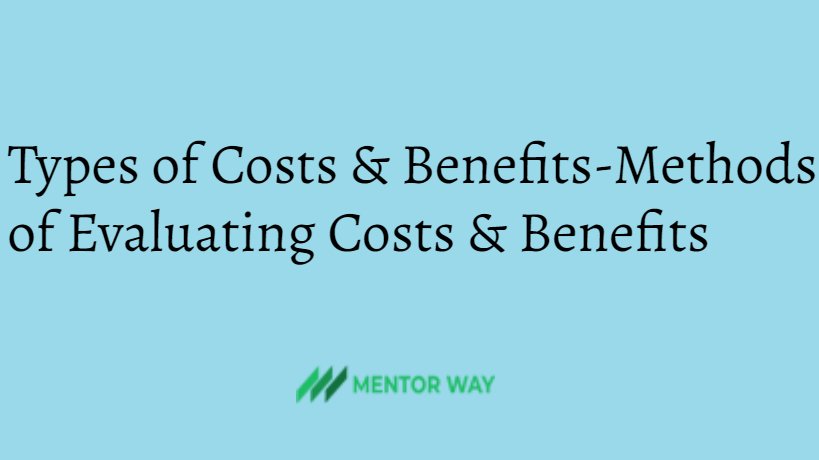Types of Costs & Benefits-Methods of Evaluating Costs & Benefits
4 min read
Types of Costs & Benefits: The primary objective of cost-benefit analysis is to find out whether it is economically worthwhile to invest in the proposed project. If the return on investment is high, them the project is considered economically worthwhile. It is done in the following steps
- Identification of costs& benefits.
- Classification of costs &benefits.
- Selection of Evaluation Methods.
- Interpret Results of the analysis & take final action.
Classification of Costs & Benefits
-
Tangible or Intangible
Tangible means that which is definite & can, therefore, be determined in advance.
Tangible cost means that it is known & can be estimated quite accurately.
For Eg.
The cost of salary of employees, equipment cost, material cost, operating cost etc.
Intangible cost refers to something which we know, but financial value of which cannot be accurately assessed.
For Eg.
The cost of the breakdown of an on-line banking system for one hour would cause the bank to lose the deposits & waste human resources.
Tangible Benefits
Tangible benefits are those savings that can be actually measured.
For Eg.
Decrease in production costs & increase in sales are tangible benefits.
Intangible benefits
Intangible benefits cannot be measured
For Eg.
Improvement in the company image due to computerization.
-
Fixed or Variable Costs & Benefits
Costs that are constant & do not change are fixed costs.
For Eg.
The purchase of an equipment, rent to be paid, purchase of software are fixed costs.
Variable Costs are those that are incurred periodically &vary with the volume of work.
For Eg.
The cost of stationery &floppies would amount of variable cost.
Fixed Benefits also remain constant. By using a new system, if 20%of stall members are reduced, we can call it a fixed benefit.
Variable Benefits
Variable benefits are realized on a regular basis.
For Eg.
The library information system that saves two minutes in providing information about a particular book to the borrower. The amount of time saved varies with the information given to the borrowers.
-
Direct or Indirect Costs & Benefits
Direct costs are those which are directly associated with a system.
For Eg.
The purchase of Floppy for Rs200/- is a direct cost.
Indirect Cost are not directly associated with a specific activity in the system. They are often referred to as overhead expenses.
For Eg.
Cost of space to install a system, maintenance of computer center, light &air – conditioning are all indirect costs.
Direct benefits also can be specifically attributable to a given project.
For Eg.
A new system that can process 25%, more transactions per day is a direct benefit.
Indirect benefits are realized as a by-product of another system.
For Eg.
A system that tracks sales calls on customers provides an indirect marketing benefit by giving additional information about the competition.
Methods of Evaluating Costs & Benefits
The common methods for evaluating cost &benefits are;
- Payback Method
- Present Value Method
- Net Present Method
- Net Benefit Method
- Break Even Method
- Cash Flow Analysis
-
Payback Method
Payback analysis defines the time required to recover the money spent on a project.
Formula
Payback Time=Overall cost outlay/ Annual cash return+ installation period.
-
Present Value Method
The payback method has certain drawbacks. The value of today’s money& tomorrow’s money is not the same. In payback method today’s cost is compared with tomorrow’s benefits & thus the time value of money is not considered.
The present value method compared the present value to future values by considering the time value of invested money. The present value analysis determines how much money it is worthwhile investing now, in order to receive a given return in some year’s time.
Formula;
n
P=F/(1+r/100)
Where P is the present value
F is the future value
r is the rate of interest
n is the number of years
-
Net Present Value Method
This method takes into consideration the time value of money & attempts to calculate the return on investment by introducing the factor of the time element.
The net present values of all inflows& outflows of cash occurring during the entire life of the project are determined separately for each year by discounting these flows by the firm’s cost of capital.
-
Net Benefit Method
In this method, the net benefit is calculated by subtracting the total estimated cost from the total estimated benefit.
-
Break Even Method
In the Break-Even Method the costs of current & new systems are compared to find the time when both are equal. This point is called a break-even point. The breakeven point is the time at which the cost of the new system equals the cost of the current one.
-
Cash Flow Analysis
Cash flow is a procedure designed to keep track of accumulated saving and expenditure on a regular basis. In cash flow analysis method, projected expenditure& costs are identified & totaled. The difference between the incoming savings& outgoing expenses is the cash flow.
Hope you liked this Article.Keep visiting Mentorway for more articles like this.



